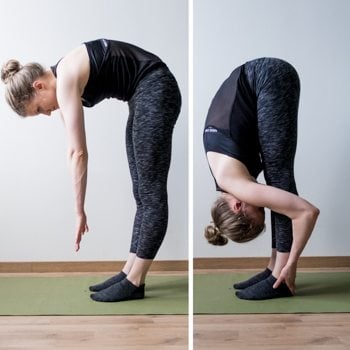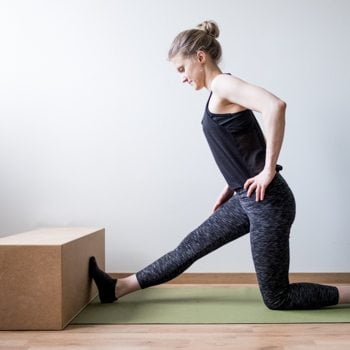Flexibility training is very frustrating for many people, especially when it appears to come so easily to some.
You’ve struggled with flexibility for a long time. You’ve looked up lots of resources to help you work on your restrictions, but you often feel like you’re just too stiff to even stretch.
When you do look for resources, it is doubly frustrating to only find limber and flexible people demonstrating the stretches. You may think, “I can’t even get into the starting position the model shows!” But no matter how tight you are, you can benefit from stretching.
 Really, although there are some people who are naturally inclined to be more flexible, most people have to work for it, and it can be a long, uphill battle if they’re following inappropriate advice for them.
Really, although there are some people who are naturally inclined to be more flexible, most people have to work for it, and it can be a long, uphill battle if they’re following inappropriate advice for them.
Flexibility means, more than anything else attributed to it, being able to go into the ranges of motion that you need to enjoy the activities in your life. Even if you’ve had trouble before in your flexibility training and it seems that you haven’t gained an inch, no matter how stiff you are, you absolutely can improve your flexibility.
In most cases, it’s just a matter of making the appropriate adjustments for you and practicing consistently.
And what I’ll show you in this article can be applied to any stretch.
🆓 Loosen Up in Just 15 Minutes
Download this free mobility routine to ease tight shoulders, hips, and legs fast. Use regularly for lasting results.
Universal Concepts for Safe Stretching
I know there are literally thousands of stretches you can find on the interwebs, and it can be confusing to know how to do them safely, especially since (unfortunately) most stretching instruction on the market is poor, at best.
The good news is, once you understand some basic principles of safe stretching, you can apply those to any stretch–yes, any stretch.
And even better news: no matter how “tight” you may be, you can follow these tips and get benefit from the stretch (especially if paired with the adjustment techniques in the next section).
1. Focus on the Spine and Pelvis
 For most stretches, you’ll want to focus on the positioning of your spine and pelvis first and foremost, as this will maximize the value of any stretch you are performing.
For most stretches, you’ll want to focus on the positioning of your spine and pelvis first and foremost, as this will maximize the value of any stretch you are performing.
There are exceptions, of course, but in most cases, the spine should be straight or slightly extended. The pelvic positioning will be tilted forward or backward (anteriorly or posteriorly) depending on the particular stretch.
You may find that you need to bend your knees or elbows, or change your shoulder positioning, in order to get your spine and pelvis where you want them–and that’s totally fine.
Don’t worry about straightening out the extremities. Get your spine and pelvis right first and you’ll improve faster.
2. Aim for Stability
 If you don’t feel secure and stable in a stretch, your body will naturally guard to protect you, making it much more difficult to let go and get what you want out of the stretch.
If you don’t feel secure and stable in a stretch, your body will naturally guard to protect you, making it much more difficult to let go and get what you want out of the stretch.
It stands to reason, then, that trying to force your body into a position it can’t get into will likely do more harm than good.
That’s why it’s important to adjust your exercises so that the positioning feels safe and secure to you and your body. Don’t worry about mimicking what the model is demonstrating. Rather, follow the positioning for the spine and pelvis, and adjust yourself so that you feel stable. We’ll go over the specifics of this in the video below.
3. Leave Yourself Somewhere to Go
 If you start in a position that is too intense of a stretch, and you can’t move at all without pain or discomfort, you’re setting yourself up for a bad situation.
If you start in a position that is too intense of a stretch, and you can’t move at all without pain or discomfort, you’re setting yourself up for a bad situation.
When people write to us saying they “can’t get into the starting position” for a stretch, we always reiterate: your starting position is wherever you need it to be. If you don’t leave yourself any room to move, you won’t get what you need out of the stretch.
So, you’ll want to always back off and give yourself enough room to move toward the feeling of stretch.
How to Adjust Any Stretch to Work for You
The three principles we just went over will help you do any stretch safely and effectively, and using the following adjustments will help you achieve those principles.
Rather than trying to mimic a stretch as a more flexible person might show it, you can follow specific concepts in positioning, making adjustments as needed to work around your own capabilities.
In this video, I show you how to adjust stretches some common stretches, using pillows/cushions/towels/chairs/stools and other such bolsters and supports, as well as different options to get into the proper position for the stretch.
🎁 Get the 15-minute stretching routine that’s helped thousands of people move better with less pain. Yours free. Just tell us where to send it.
So the main points for adjusting a stretch you find difficult are:
- Fill in the Spaces–If you don’t have enough flexibility to have contact between your body and the ground (or your torso and your legs), use towels, pillows, or other supports to fill in those spaces. There is no need to use exactly the props shown in the video–just use whatever you have lying around.
- Support Yourself–If you feel unstable or unsafe, use whatever supports you need to, even if it means sitting on a chair to do the stretch.
- Bend Your Extremities as Needed–Remember the key principle of keeping your spine neutral (or slightly extended) and your pelvis in the proper position. Bend your extremities however you need to in order to maintain these positions in the spine and pelvis.
No matter how much you may struggle with flexibility, using these principles and adjustments will help you get as much as you can from any stretch.
Three Steps to Help Even the Least Flexible People Become Flexible
1. Work with, not against, gravity

If you’re very inflexible, try changing the angle of a stretch so that gravity works in your favor.
Often, people will try a stretch, find they “can’t get into it,” and either try to force it or give up.
For instance, there are many exercises to choose from to stretch your hamstrings. But if you are unable to sit up straight, working on it directly on the ground is making it harder than it needs to be. You are fighting against gravity, making it difficult to relax.
In the video above you can see that a simple way to overcome this is to sit with your butt higher than your feet. From this position you can start using gravity to help you stretch forward.
This is just one example, but the key point is to modify stretches as needed, so that you are allowing gravity to pull you in the direction you’re trying to go. By working with gravity, you will allow your body to relax into the stretch, giving you a greater range of motion.
2. Stretch your tightest areas consistently

It’s almost a guarantee that progress won’t be linear (it rarely is). The key is to keep showing up anyway.
It is easy to get discouraged with stretching, especially when results are slow. It can take weeks or even months to see and feel improvements in ranges of motion, and getting a high level of flexibility – whether overall or in specific positions – can take years of work. Progress will not be linear. Some weeks you will make big improvements, other weeks will be less. But be consistent in your practice and you WILL see results.
But results will come faster if you keep focused on your tightest areas, and prioritize them. What if everything is tight? You might have tight hamstrings, tight shoulders and tight hips. Your whole body! So what then?
3. Play with new ranges of motion from your stretching session

After stretching, use your increased flexibility in different motions. This will help your progress “stick.”
Spending 10 minutes stretching your hamstrings every day is great. But you are also spending 23 hours and 50 minutes not stretching your hamstrings!
So how do we ensure that you maintain your flexibility gains? Play in that new range of motion!
After you have done your flexibility work spend some time playing with locomotive patterns that put your new ranges of motion to work. If you’ve been working on your squat flexibility, for instance, play around with the monkey and frogger for a few minutes.
Enjoy seeing how your increased flexibility carries over to your skill work. Play and have fun!
A Sample Workout to Put These Tips to Work
 Here’s a simple and effective session to show you how to put these tips into action. This is specifically for the hamstrings but the structure can be applied to any area.
Here’s a simple and effective session to show you how to put these tips into action. This is specifically for the hamstrings but the structure can be applied to any area.
Perform this at the end of your regular training program:
1. Standing Knee to Chest
- Do 2 sets of 10 on each leg.
2. Seated Hamstring stretch
- Get into the stretch position
- Move into and out of the stretch 5 to 10 times
- Move into the stretch and relax and hold for 30 seconds
- Repeat up to 3 times.
- Switch legs.
3. Bear Walk
- Build up to 3 minutes of non-stop bear walk.
Don’t be discouraged if you haven’t made the progress you want in the past. Start using some of the tips described in this article, and give yourself a chance to make lasting change in your flexibility.
Use It or Lose It? Don’t Neglect Movement
One frustrating thing about flexibility is that it doesn’t last if you don’t use it. This is something a lot of us experience after taking some time away from training, but lack of adequate movement can also slow your progress when you are stretching regularly.
Athletes drill and practice constantly to cement the strength, stamina, and flexibility they develop in the gym, and we encourage you to get out and move your body in as many different ways as possible, as often as possible to give yourself plenty of practice using your capabilities. That’s also why we included the bear crawl in the sample program up there and talked about using locomotion exercises.
In fact, this is the same method we use with our clients – specific stretching exercises paired with application in locomotor patterns.
Stretching + Movement for Reliable Flexibility Gains
GMB Mobility is a guided program that improves your total body mobility. You’ll resolve restrictions so you can finally move and perform your best.


